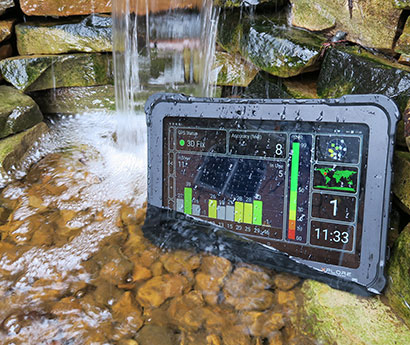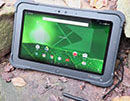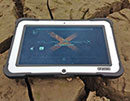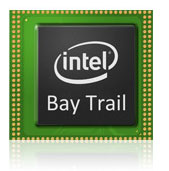|
Xplore Technologies XSlate D10
Xplore adds a much more powerful version of its compact, lightweight, and well-connected rugged Android tablet platform to its growing lineup of mobile solutions for the road
(by Conrad H. Blickenstorfer) — View print version of Xplore XSlate D10 review
Just a couple of months after Xplore Technologies introduced the XSlate B10 as an updated and much more powerful version of their Windows-based Bobcat tablet, the company used the same approach on the Android side: the new XSlate D10, announced November 10, 2015, is an updated and seriously beefed up version of Xplore's existing RangerX. The only difference is that the new XSlate D10 replaces the RangerX, whereas the XSlate B10 complements the Bobcat.

For those unfamiliar with Xplore's thin-and-light tablets, they have 10.1-inch displays and roughly the same footprint as the company's ultra-rugged iX104 Series tablets, but they're only half as thick and weigh less than half as much. They use projected capacitive multi-touch, don't have a supplementary active pen, and cost significantly less than the top-of-he-line iX104s. Do not view them as junior versions of the iX104 Series, though. The XSlate Series, both on the Windows and on the Android side, are conceived as tougher and more reliable alternatives to standard consumer tablets.
As far as physical specifications go, the XSlate D10 measures 11.1 x 7.1 inches and is 0.85 inches thick. That's a bit larger and quite a bit thicker than consumer media tablets in this class. With 2.4 pounds, the new XSlate D10 weighs a pound and a half more than an iPad Air 2, but much less than traditional Windows-based rugged tablets. In terms of design and build, the XSlate D10 uses a magnesium alloy frame with elastomer edge and corner protection like the iX104 line, but it has its own distinctive look.
What's different: XSlate D10 vs. RangerX?
Since the XSlate D10 is an update of the existing Xplore RangerX, let's just start with a table that shows the major differences. Visually, the new XSlate D10 and the RangerX are near identical, except that the Bobcat has a dark-gray bezel and the RangerX had a white one. Under the hood, however, the new tablet packs a much bigger punch.
|
XSlate D10 vs RangerX
|
XSlate D10
|
Ranger X
|
|
Introduced
|
11/2015
|
07/2013
|
|
|

|

|
|
CPU
|
Intel Atom E3845
|
TI OMAP 4470
|
|
Cores
|
4
|
2
|
|
Clock Speed
|
1.91 GHz
|
1.50 GHz
|
|
OS
|
Android 5.1 (Lollipop)
|
Android 4.2.2 (Jelly Bean)
|
|
RAM
|
4GB DDR3L 1333
|
1GB or 2GB LPDDR2
|
|
Storage
|
64GB SSD
|
32GB eMMC
|
|
WiFi
|
802.11ac
|
802.11a/b/g/n
|
|
USB
|
2 x USB 3.0
|
USB 2.0 host and client
|
|
GPS accuracy
|
2.5 meter
|
5.0 meter
|
|
Battery life
|
Up to 8/14/20 hrs
|
Up to 10 hrs
|
|
Front camera
|
2.0mp
|
1.2mp
|
|
Drop spec
|
5 feet
|
4 feet
|
|
Weight
|
2.4 lbs
|
2.2 lbs
|
Before we get into the new hardware, let's talk about the software. The new XSlate D10 comes with Android 5.1 "Lollipop," whereas the RangerX was/is at the still widely used Android 4.2.2 "Jelly Bean." That's relevant as Android version 5.x introduced a number of features  welcomed by enterprise customers. Among them are much improved device protection, 64-bit processor support, improved Bluetooth and WiFi connectivity and — most importantly — significantly improved security. welcomed by enterprise customers. Among them are much improved device protection, 64-bit processor support, improved Bluetooth and WiFi connectivity and — most importantly — significantly improved security.
That's relevant and perhaps a crucial step forward towards Android adoption in the enterprise. Why? Because whereas Android dominates the non-Apple smartphone market and even enterprise customers are attracted to the greater ease of use compared to Windows, security and secure management concerns have been roadblocks to Android acceptance in vertical and enterprise markets. We'd add the rapid succession of new Android versions and the overall fragmentation of the Android market to those concerns, but agree that the version 5.x features will likely help open IT doors.
Display
The XSlate D10 display appears to be the same, or very similar, that was used in the RangerX. That means it measures 10.1 inches diagonally, has 1366 x 768 pixel resolution (16 : 9 aspect ratio), and a bright 500 nit backlight. 1366 x 768, to many known as 720p, is more than the original iPad and works well with Android on this size screen. The display uses IPS AFFS+ LCD technology, which offers perfect viewing angles from all sides. Direct-bonding of layers and special optical coatings minimize reflectivity, making the screen quite sunlight-readable and thus suitable for work both indoors and outdoors. There are some reflections outdoors, but less on most consumer tablets.
Projected capacitive multi-touch works best with a smooth glass surface that extends well beyond the display itself and the XSlate D10 has that, so it is pleasant to operate. Android, of course, has been optimized from the start for procap touch, and there are none of the usability issues Windows Classic has with touch. Also note that while most procap consumer tablets have a completely flat front surface, the glass on the XSlate D10 extends about a quarter inch beyond the LCD perimeter, then there is a very slight rise to the white bezel around the screen, and after another 5/8th of an inch the raised rubber protective guard.
Of note is the D10's ability to switch from finger touch to glove touch mode. We tested the tablet with gloves on. It works, but, of course, not as well as with bare fingers, and it also depends on the thickness and material of the gloves.
Speedy Wintel tech
Whereas the RangerX ran on a 1.5GHz dual-core TI OMAP processor, the XSlate D10 is powered by a beefy 1.9GHz quad-core Intel E3845 that's part of Intel's Bay Trail platform. It's also part of Intel's E3800 system-on-chip product family that so happens to support Android. The use of a standard Intel processor makes this tablet different from every other Android tablet or handheld we've tested.  All of those used ARM-based processors from Texas Instruments, QualComm, Nvidia, MediaTek, etc. All of those used ARM-based processors from Texas Instruments, QualComm, Nvidia, MediaTek, etc.
This also means the XSlate D10 comes with genuine Intel graphics of inherently the same HD 4000 architecture and variety as those used in Intel's 3rd generation "Ivy Bridge" processors, albeit with fewer execution units (four instead of several times that number) and lower clock speeds. Intel HD Graphics' claim to fame is usually that it includes and supports Wintel APIs and features, and how all that translates into the Android experience we don't know as of yet.
There are significant differences on the RAM and storage side as well. Whereas the RangerX had just 1GB of lowly LPDDR2 (also known as "mobile" RAM) SDRAM, the XSlate D10 comes with 4GB of much quicker 1,300MHz DDR3L.
Mass storage is also at a much more sophisticated level. The RangerX had of 32GB of eMMC NAND Flash. The "e" stands for "embedded" and eMMC uses a basic controller and a relatively slow interface. The XSlate D10, on the other hand, comes with s 64GB Solid State Disk. SSDs use complex controllers and one of the various speedy SATA interfaces (M.2, the successor of mSATA, in the D10). Mass storage can be complemented via a user-accessible micro-SDXC card slot. For power, a replaceable 39.2 watt-hour battery is good for up to eight hours of operation. If that's not enough, there are two optional external snap-on battery options (see picture in the sidebar) that provide hot swappability and boost battery life to 14 or 20 hours.
Connectivity galore
For onboard connectivity, xSlate D10 users get two full USB 3.0 ports instead of just the USB 2.0 host and client ports of the RangerX. Micro HDMI-out as well as optional HDMI-in and a RJ45 LAN jack carry over. On the wireless side, WiFi is now of the faster 802.11ac variety, there's Bluetooth 4.0, and optional Sierra Wireless 7355 4G LTE mobile broadband. Integrated GPS now is twice as accurate (2.5 meters versus 5 meters in the RangerX). Resolution of the integrated webcam went from 1 to 2 megapixel, but the rear-facing documentation camera stays at 5mp.
The XSlate D10 has significantly more onboard I/O than most tablets this light and compact. The illustration below shows the two I/O blocks on the left side of the unit. One caveat here: the micro HDMI port is a bit fragile.

Xplore especially emphasizes the availability of HDMI-in, as that feature is often required by satellite, cable, broadband and telecommunications providers to validate and diagnose installations or services issues on-site. And if industrial grade scanning is needed, there's an optional bolt-on 1D/2D barcode reader.
Remarkable ruggedness
The XSlate D10 is a rather stylish device that borrows the general size and form factor of consumer tablets, with attention to good looks and as slender a profile as possible. Can it still be rugged?
As is, Xplore says the XSlate D10 successfully passed the MIL-STD-810G transit drop test of 26 5-foot drops to plywood over concrete while operating. That's a foot more than the RangerX can handle. The tablet can operate in a very wide temperature range of -34 to 140 degrees Fahrenheit (albeit with a cold start limit of -4°F), enough for virtually any conceivable deployment.
Sealing is at the IP65 level, where the "6" stands for being dustproof and the "5" for the ability to handle low pressure water jets from all directions. As is shown in the picture on the right, our test D10 easily survived a good hosing under a waterfall. And while most manufacturers only claim a 15,000 feet altitude limit, Xplore says the XSlate D10 can handle 40,000 feet, which is roughly the cruising altitude of commercial airplanes. The ability to handle that altitude in an unpressurized setting is definitely a plus.
Xplore is also remarkably proactive in listing all performed ruggedness tests in detail. Much appreciated, and certainly a big plus for customers.
The Xplore XSlate D10
With the XSlate D10, Xplore Technologies has now also brought its Android-based thin-and-light (but still very rugged) 10.1-inch tablet technologically up-to-date. This means greater processing and communications performance for a platform that can also draw on a remarkably broad and complete lineup of supporting and complementary peripherals. On top, enterprise customers will appreciate improvements in security, standards, and performance issues that come with Android 5.1.
|



